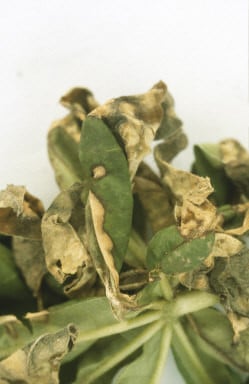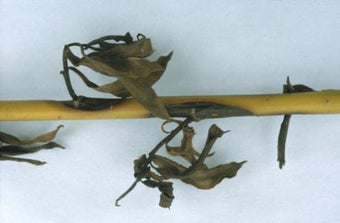
Quick facts
Common name - Lupin anthracnose
Scientific name - Colletotrichum species
Plants affected - Lupin
Main symptoms - Dead patches of brown tissue on leaves and stems, often covered in orange spores. ‘Corkscrewing’ of leaf stalks
Caused by - Fungus
Timing - Spring and summer, particularly in wet conditions
What is lupin anthracnose?
Lupin anthracnose is a fungal disease of the leaves and stems. It is spread from plant to plant by rain-splashed spores, and is therefore particularly damaging in wet weather. Affected plants are not usually killed, but can become very unsightly as a result of severe leaf-spotting and dieback.
Anthracnose first became a problem on ornamental lupins in the 1980’s, and is now the most damaging disease affecting them. It is also a problem on commercial field crops of lupins, which are grown for their seeds, rich in protein and oil.
Symptoms
Lupins suffering from lupin anthracnose will look unsightly;
- Brown areas of dead tissue (necrotic lesions) on leaf blades, leaf stalks, stems, flower stalks and seed pods
- Under wet conditions the fungus produces a slimy mass of orange-coloured spores on the surface of the affected areas
- Affected leaf stalks will sometimes coil several times to give a ‘corkscrew’ appearance, which is very characteristic of anthracnose
- Severely affected leaves may shrivel and turn brown
- The growth of stems and flower stalks may become distorted, or they may collapse completely, due to points of weakness caused by the lesions

Control
The RHS believes that avoiding pests, diseases and weeds by good practice in cultivation methods, selection, and encouraging or introducing natural enemies, should be the first line of control. If chemical controls are used, they should be used only in a minimal and highly targeted manner.
Non-chemical control
- Inspect plants carefully prior to purchase for any symptoms of anthracnose
- Pick off and destroy affected leaves of plants in the garden, if only one or two leaves show symptoms. Monitor the plants closely for any further development of symptoms
- Severely affected plants should be removed and disposed of as soon as possible. Ensure that no debris remains on the soil surface
- Avoid dense plantings, so that air can circulate freely around the plants
- Avoid overhead watering, particularly where the disease is present
- Do not save seed from affected plants
- If repeated infection occurs, consider replacing lupins with another herbaceous plant
Fungicides
The RHS recommends that you don't use fungicides. Fungicides (including organic types) may reduce , impact soil health and have wider adverse environmental effects. If you do intend to use a fungicide, please read the information given in the link and download below to ensure that use, storage and disposal of the product is done in a responsible and legally compliant manner.
The products listed in the ‘Fungicides for gardeners’ document below are legally available for use by home gardeners in the UK. This information is provided to avoid misuse of legal products and the use of unauthorised and untested products, which potentially has more serious consequences for the environment and wildlife than when products are used legally. Homemade products are not recommended as they are unregulated and usually untested.
There is no specific information available on the efficacy of any home garden fungicide against lupin anthracnose.
Download
Fungicides for gardeners (Adobe Acrobat pdf document outlining fungicides available to gardeners)
Link
Cause
Lupin anthracnose is caused by the fungus Colletotrichum. A number of species have been associated with the problem, including Colletotrichum lupini, C. acutatum and C. gloeosporioides. The disease is favoured by periods of warm, wet weather. The orange spore masses that develop on the surface of the lesions contain huge numbers of microscopic spores, and these are splashed around by rain droplets (or by overhead watering). They will germinate and infect the plant if the leaf or stem surface stays wet for a few hours, eventually producing new lesions.
The fungus can be found at the very base of affected stems, and sometimes on the roots, so the problem can develop again even if affected plants are cut back hard. Seed can also become contaminated by the anthracnose pathogen.









